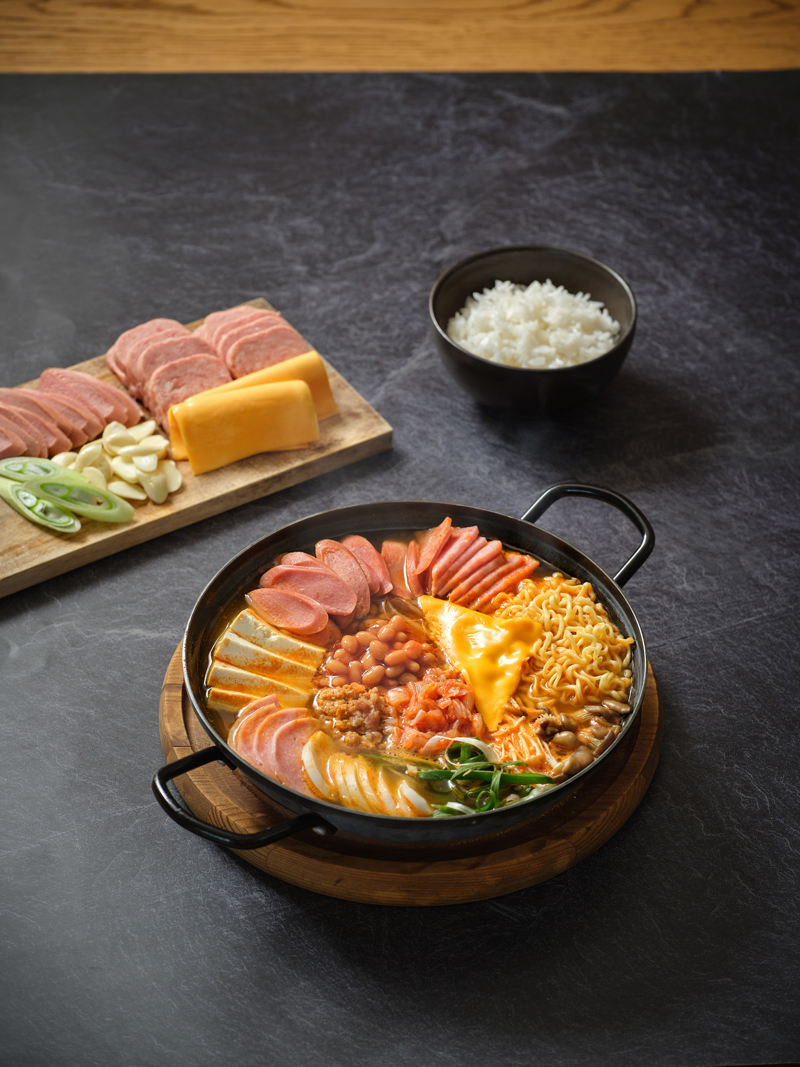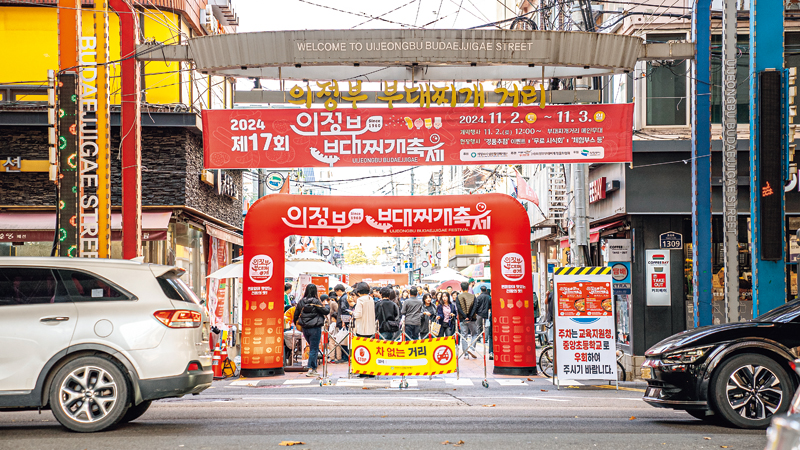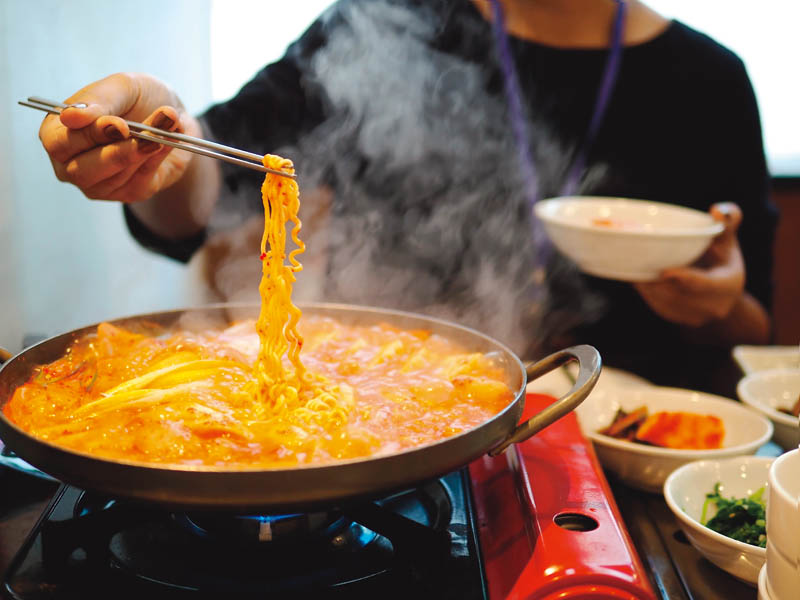Budae jjigae is a dish that was born in the aftermath of the Korean War, a challenging time when many Koreans struggled to have even one full meal a day. The hearty stew provided much comfort thanks to its abundant ingredients, but its appeal went beyond mere sustenance. People came to love the fusion of Western ingredients and Korean flavors.

Budae jjigae, a dish that combines Korean staples like kimchi and gochujang with Western ingredients such as ham, sausage, and baked beans, exemplifies the fusion of two distinct food cultures.
A nation's food culture is shaped by a unique combination of factors. Some of these are rooted in geography, including climate and soil, others are external influences, such as historical events and natural disasters. Wars and conflicts have significantly impacted food cultures worldwide. One notable example is the hotpot dish made by parboiling vegetables and thin slices of beef in a bubbling broth. According to legend, it was introduced to different parts of the globe by invading Mongol armies during the conquests of Genghis Khan and is commonly known today as shabu shabu. Another example is the development of canned food, which started with a prize offered by Napoleon to improve food preservation methods in order to provide quality provisions for his troops.
MILITARY ORIGINS
Budae jjigae emerged in the aftermath of the Korean War, which broke out in 1950. The armed conflict left lasting scars on the Korean peninsula, dividing it into two states with opposing ideologies. Even after the signing of the armistice agreement in 1953, which put an end to active hostilities, U.S. military forces remained stationed in cities around Seoul, including Uijeongbu, Paju, and Songtan (now part of Pyeongtaek). As the name suggests — budae jjigae literally means “army base stew” — the dish is inextricably linked to these military bases.
Budae jjigae is a spicy stew that combines ham, sausage, bacon, ground meat, baked beans, and kimchi in a broth flavored with gochujang, fermented red pepper paste. Instant noodles can also be added for texture and flavor. But how did this dish become such a favorite of Koreans today?
To find the answer, we can look to Odeng Sikdang in Uijeongbu, one of the first establishments to serve the dish. The founder began selling budae jjigae at a pojangmacha, a covered street food stall, in 1960. Initially, the dish was not even on the menu. According to the restaurant’s website, the proprietor first offered stir-fried dishes consisting of ham, sausage, and bacon — ingredients she sourced from someone working at the nearby U.S. military base. However, since rice is the staff of life for Koreans, regular customers soon began asking her toa soup dish they could eat with it. After some consideration, the vendor decided to add water, kimchi, and gochujang to the existing stir-fried dishes and boil all the ingredients together, thus creating the first budae jjigae.
People quickly fell in love with the taste of sausage, ham, and bacon, and the spicy broth turned out to be the ideal match for rice. Word of this new creation spread rapidly, attracting more and more customers to the food stall. Other budae jjigae restaurants began to spring up in the area, ultimately creating an alley full of places specializing in the dish, which was officially designated Uijeongbu Budaejjigae Street in 2009.
Most renowned budae jjigae establishments are located near U.S. military bases, particularly in cities on the outskirts of the capital, like Uijeongbu, Dongducheon, and Pyeongtaek, as well as in Gunsan, North Jeolla Province, and in Seoul’s Yongsan District, where the headquarters of the U.S. forces in Korea was situated until 2018. Each of these areas offers its own version of the dish.
Interestingly, it is sometimes referred to as “Johnson Soup” (Johnson tang), a name inspired by U.S. President Lyndon B. Johnson, who visited South Korea in 1966.

Uijeongbu Budaejjigae Street in Gyeonggi Province is the birthplace of the iconic dish and now home to an annual festival celebrating it.
© Uijeongbu Market Revitalization Foundation
DEFINING INGREDIENTS
In Western dishes, sausages and ham are most commonly served grilled or as sandwich fillings, so the idea of enjoying them in a soupy stew may seem unusual.
But for many Koreans, no meal is complete without a soup dish. In budae jjigae, the meats are cooked directly in the broth, becoming tender while maintaining their chewiness, and releasing their fatty juices into the stew to give it a richer taste. The real standout elements, however, are the baked beans and kimchi, which play a crucial role in enhancing the overall flavor profile. The soft, tender beans create a delightful contrast to the chewy sausages and ham, and form a winning combination that brings a smile to the face. Meanwhile, the spicy flavor of the well-cooked kimchi provides the depth at the heart of the dish. Using tasty kimchi is crucial in bringing out the best in the other ingredients.
Some restaurants offer the option of adding instant noodles or tofu to the dish, while others go a step further by topping it with American cheese slices. The noodles offer a welcome carbohydrate boost, while the cheese melts delightfully into the broth, adding a touch of decadence to each spoonful. Cheese is not only reserved for budae jjigae, it is also a common addition to other Korean dishes such as dakgalbi (spicy chicken stir-fry), deunggalbi (grilled pork ribs), and tteokbokki (stir-fried rice cakes), bringing a twist to each of these classics.

Thanks to its hearty mix of ingredients and rich, savory taste, budae jjigae has become just as popular as other classic Korean dishes like kimchi jjigae and doenjang jjigae.
© Shutterstock
TIME-HONORED RESTAURANTS
Where is Korea’s best budae jjigae to be found? Given the abundance of restaurants serving this popular dish, any neighborhood is guaranteed to boast a handful of options. Chain restaurants are widespread across the country, and even convenience stores sell it in ready-to-eat packs. However, the best place to truly appreciate the dish and its rich history are restaurants that have been around for a long time. Notably, budae jjigae recipes and names vary slightly depending on the region.
The origins of Uijeongbu-style budae jjigae can be traced back to Odeng Sikdang, which has been serving the dish for three generations. Here the ingredients are stir-fried and seasoned beforehand, but baked beans are omitted, resulting in a milder flavor without the added sweetness.
The famous Uijeongbu version finds its match in Songtan-style budae jjigae. While Songtan was once a city in its own right, it was merged with the city of Pyeongtaek in 1995. What sets this variation apart is its beef bone broth, which gives the stew a richer flavor and thicker consistency. It is also topped with American cheese and includes ground beef and green onions. The most renowned establishments in the area are Choinaezip Budae Jjigae, Gimnejip, Hwangsojib, and Ttaengjip. Choinaezip Budae Jjigae dates back to 1969, when the founder, who at the time operated a small restaurant, was encouraged by friends working at the nearby U.S. military base to begin selling the stew. Gimnejip is known for its strict policy of accepting requests for additional sausage and ham only with the initial order. This is because the stew, cooked at the table, may become overly salty if more processed meats are added as it boils down. Instant noodles must be added just at the right moment, specifically when the stew is halfway cooked, to ensure that they attain the ideal texture. At Hwangsojib, the broth is made using bones of hanu, Korean beef, and is less spicy than other variations on offer in Songtan.
While Paju-style budae jjigae may not enjoy the same level of recognition as more popular other versions, it has cultivated a loyal following for its generous amount of vegetables, especially crown daisy, a leafy green commonly used in Korean cuisine. It also has a lighter flavor as it isn’t made with bone broth. The most famous budae jjigae places in Paju are Wonjo Samgeori Budaejjigae, in operation for more than fifty years, and Jeongmi Sikdang Budae Jjigae, which opened in the 1990s and remains a favorite among locals.
Gunsan-style budae jjigae differs from other local versions as it is made with beef broth and served with a topping of thin beef slices, like the cold noodle dish Pyongyang naengmyeon. Bihaengjang Jeongmun Budae Jjigae, which opened in 1984, is a Gunsan old-timer. Interestingly, its menu also features hamburgers, which many customers order on the side.
Many renowned budae jjigae restaurants are also found in Seoul, with Bada Sikdang in Itaewon in Yongsan District often regarded as the best. In business since the 1970s, it lists the dish on its menu as Johnson tang.
Budae jjigae is a uniquely Korean dish that was born out of the harsh realities of the postwar era and reflects the creative spirit of Koreans. People continue to enjoy its spicy yet comforting taste, which helps to heal old wounds and cope with the challenges of everyday life.
Park Mee-hyang Food journalist
Lee Min-hee Photographer